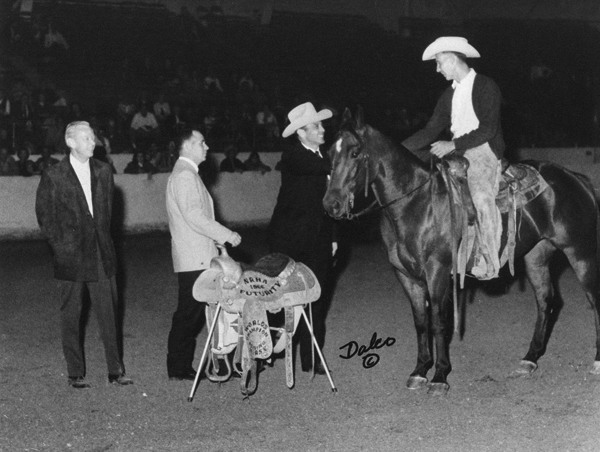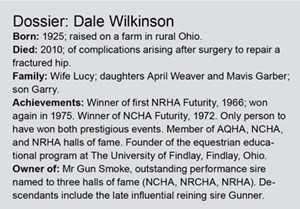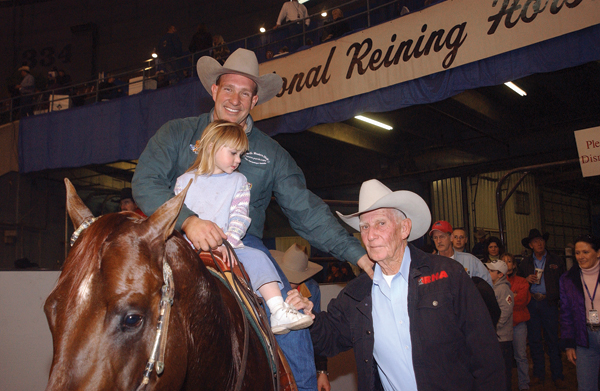I was 11 years old the first time I encountered Dale Wilkinson. Although the late trainer has long been revered as “the father of modern reining,” I had no idea who he was. But he was about to influence me greatly, as he would so many others who saw him ride and benefitted from his visionary approach to reining.

I’d accompanied my father to the Ohio State Fairgrounds in Columbus, where the annual Midwestern Horse Show and Rodeo was going on in July 1960. I had an old Paint gelding at home that I rode about five hours a day, so my natural interest was high.
Taking a seat in the coliseum, I saw about 20 horses come in, one at a time, and do things I’d never seen horses do. One man stood out as he performed the maneuvers. He was very different from the others, and so was his horse. It’s hard for an 11-year-old to put such impressions into words, but I remember thinking something like, “This guy and his horse make it look so easy and pretty, I think I would really like to do this myself.” As the man was called out to get the first-place trophy, I learned his first name was Dale, the same as my father’s. Back at the stalls, he spotted me and said “hi there” in a friendly tone. I was more awed than if The Lone Ranger had spoken to me.
In later years, as I developed my own career as a professional reining trainer, my early role model and I became close; he gave me his first trophy buckle to remember him by. During the 50 years between my first view of him and his death in 2010, I learned a great deal about Dale Wilkinson, the man. That’s what this article is about—not his unequaled accomplishments as a horseman (see page 69), but the individual behind them.
An Intelligent But Humble Thinker
Dale was an extremely intelligent man who had few hobbies; his favorite pastime was thinking. Even at the height of his fame and fortune, Dale was just another guy. He didn’t have to feign humility, as it was just part of his nature. He was of average height and build, didn’t smoke or drink to any extent, and though he did chew tobacco in his early years, he gave it up.

He was first and foremost a family man who took great pains to separate his business life from his family life. Dale was a horse trainer second, and a horse trainer only; his honesty kept him from being much of a salesman. Not only would he tell a prospective customer what he liked about a horse, he’d lay out everything he didn’t like about him, too. I’m not sure Dale could’ve sold snow cones in South Africa. However, his integrity kept his barn full of good horses, from the west as well as the east.
Born in 1925, Dale started training horses in the late 1940s, moonlighting at the Hancock County Fairgrounds in Findlay, Ohio, where he rented a few stalls. A few years later, he and wife Lucy purchased some open land about five miles outside Findlay and right next to the Old Mill Stream. Thus he opened Millstream Stables, where he trained horses for over 25 years before selling the property to The University of Findlay and moving to his final farm in rural Waynesburg, Georgia.
Compared to other trainers, Dale didn’t attend a lot of horse shows. His schedule included three large shows at Columbus, Ohio; the Chicago International; the Indiana and Michigan state fairs; and a few weekend cuttings. I only saw him once at a weekend Quarter Horse show. He attended some of the large Western stock shows early in his career, building his reputation, but largely preferred to stay home, train, and be with his family.

I firmly believe Dale’s main interest in horses was in training them. While he did have success as a breeder with his Quarter Horse stallion Mr Gun Smoke, it sure wasn’t from all the dollars he spent on advertising him nor all the good mares he bought to breed to him. Gun Smoke pretty much had to do it on his own—and he did, with siring ability that got him into the NCHA, NRCHA, and NRHA halls of fame for cutting, working cow horse, and reining.
His Family Came First
If you sent a horse to Dale, expecting to be wined and dined, you sent it to the wrong trainer. Dale’s finished horses did his talking for him. Dale had little use for pomp and ceremony, let alone partying or blowing his own horn. This doesn’t mean he was unsociable. He was quite outgoing, would and could talk to anyone, and liked to have a good time as much as anyone—but only in his way, and when he felt it was appropriate.
He had a good but extremely dry sense of humor, such that many people didn’t get his point for hours, if ever. He could use that dry humor to jerk a person’s chain, and that may have been his second-favorite pastime, after thinking.
Most days, when working at home, Dale would disappear inconspicuously, leaving the help and any guests behind. He was in the house, having lunch with his family, and enjoying their company. Dale rightfully believed Lucy had enough to do with raising three children, keeping the books, and running their home, without having to cook for and clean up after the visitors who were there on any given day. On the day or two a week when Dale didn’t eat lunch at home, he went to a small diner just down the road. The diner had a small bumper-pool table, and he’d play a few games while waiting for his food. He was as good with a cue and ball as he was with a bridle and reins.
Even in Dale’s busiest years, he tried to take any and all family members with him who wanted to go to the shows. He was a very happy and proud father whenever daughters April or Mavis had a good run, and if he had any criticisms, they were always quiet, constructive, and laced with his famous dry humor.
The only time I ever saw Dale do anything out of his norm was when he showed a horse at halter for the first and likely only time. Cotton Marriott, a breeder from Texas, had sent the stallion Taco Bar Lee to Dale to get reining points and finish qualifying for his AQHA Championship. Dale had no interest in halter whatsoever, but there he was, spurs and all, leading Taco Bar Lee into an aged stallions class at a show in Columbus.

Standing about five feet in front of the horse with his free thumb hooked in a pants pocket, he looked like a feller holding a mule, waiting for someone to put a harness on him. The crowd buzz at this sight was so loud you’d think people had just seen Dale mark a 79.5 in reining. As usual, Dale had the last laugh, for he won the class with Taco Bar Lee and then got the nod for the grand championship.
As you probably could guess by now, Dale had no interest in being a politician. He held some early positions with the National Reining Horse Association, but that was only to help the organization get started down the right path. From 1966 to 1982, the top 20 all-time futurity riders, including Dale, were automatically on NRHA’s advisory board. Holding positions myself from 1975 through most of the ’80s, I don’t recall ever seeing Dale at a board meeting. It just wasn’t his style. Yet he freely gave away all the advice asked of him in an informal way, whether it was in regard to judges, patterns, rules, or other topics.
Where None Had Gone Before
Today, prospective reining trainers have many resources. They know what’s expected of them, what a good, bad, or so-so maneuver looks like, and what judges want to see. They have at their disposal such tools as reining books, clinics, and DVDs, not to mention equine prospects resulting from decades of specialized breeding. They can go to a top trainer’s place to watch, ride with him, and ask questions. And even with all this available, the percentage who make it to the top of the game is very small.

Now let’s go back to the late 1940s and early ’50s, when reining was little more than a contest class with no finesse, style, definition, or description of maneuvers. The horses’ heads were everywhere but where they should have been for collection and control.
Dale took this mess and molded it into the sport it is today. The stepping turnaround, slack reins lightly guiding, symmetrical circles, smooth sliding stops, rapid backups, controlled speed, horse yielding at poll and chin—all these aspects of modern reining originated with Dale. Try to imagine what kind of mind could, with the help of no one, conceive and achieve an advancement of this magnitude.
Ohio is known for its great inventors: Thomas Edison, the Wright Brothers…and Dale Wilkinson. Yet for all he invented and gave to the horse world, Dale was someone who’d have wanted most to be remembered as a man who loved his family, loved his work, and did an honest day’s work for an honest day’s pay.
Larry Rose, Lexington, Ohio, had a long and successful career as a trainer until he became disabled in 2006 from a riding accident that broke his neck and crushed his spine. No longer able to ride, he now spends his time documenting and writing articles about pioneering horsemen such as Dale Wilkinson.






